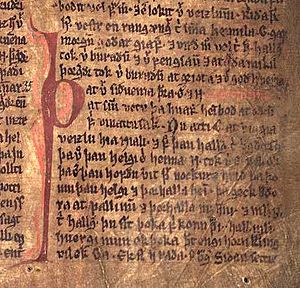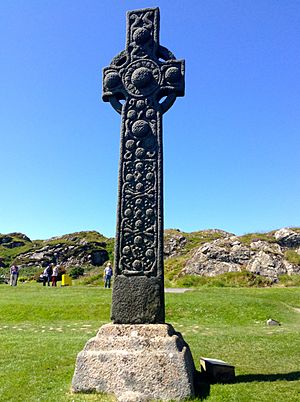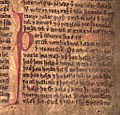Sigurd the Stout facts for kids
Quick facts for kids
Sigurd Hlodvirsson
|
|
|---|---|
| Earl of Orkney | |
| Title held | 991 to 1014 |
| Predecessor | Hlodvir Thorfinsson |
| Successor | Brusi, Sumarlidi and Einar Sigurdsson |
| Native name | Sigurðr digri - Sigurd the Stout |
| Died | 23 April 1014 Clontarf |
| Noble family | Norse Earls of Orkney |
| Spouse | Olith, daughter of Malcolm II of Scotland |
| Issue | Hunde, Brusi, Sumarlidi, Einar and Thorfinn |
| Father | Hlodvir Thorfinnsson |
| Mother | Eithne |
Sigurd Hlodvirsson (born around 960, died April 23, 1014) was a powerful leader known as Sigurd the Stout. He was an Earl of Orkney, which means he ruled the Orkney Islands. His story comes from old Norse Sagas, which are like epic tales written long after he lived. Because of this, we should remember these stories are not always exact historical facts.
Sigurd was the son of Hlodvir Thorfinnsson. He was also a direct descendant of Torf-Einarr Rognvaldson, an important figure in Orkney's history. Unlike some other rulers of his time, Sigurd's rule was mostly free from family fights over power. This allowed him to expand his influence across a large area. He also controlled lands in northern Scotland and the Hebrides. He might have helped defeat Gofraid mac Arailt, who was the King of the Isles. Records from Ireland, called the Annals of Ulster, mention his death at the Battle of Clontarf in 1014. This is the earliest known mention of the Orkney earldom.
The sagas also talk about Sigurd becoming a Christian. They mention his special "raven banner," a flag with a raven symbol. This symbol was linked to the Norse god Odin. The stories about his life and the lack of clear records mean that historians have different ideas about what really happened.
Contents
Sigurd's Family and Early Life
The Orkneyinga Saga tells us that Sigurd was the son of Hlodvir and Eithne. Hlodvir was one of the five sons of Thorfinn Skull-Splitter. Eithne was said to be the daughter of a "King Kjarvalr." After Earl Thorfinn died, there were many family struggles for power. Three of Hlodvir's brothers ruled before him. Hlodvir himself died peacefully and was then followed by Sigurd, likely in the 980s.
Sigurd's family name, Hlodvirsson, is a bit unusual. It seems to be connected to the old roots of the modern French name "Louis."
Sigurd's Rule as Earl
Sigurd was lucky because when he became earl, there weren't many other strong people trying to take his place. This meant his rule was different from earlier times, which had many bitter family fights.
Sigurd's great-grandfather, Torf-Einarr, had lost some important rights for the farmers of Orkney and Shetland. These were called udal rights. Sigurd was able to get these rights back for the farmers. A collection of silver ring-money, found in Burray, dates to Sigurd's time, between 997 and 1010.
Controlling Mainland Scotland
Sigurd's lands included not only Orkney and Shetland but also large areas in mainland Scotland. For these Scottish lands, his rulers were the Kings of Scotland, not the Kings of Norway. We are not sure exactly how much land he controlled. Some stories, like Njal's Saga, say he ruled Ross, Moray, Sutherland, and the Dales. At that time, Moray would have included areas on the west coast like Lochaber. During Sigurd's time, the earldom reached its peak power. His son Thorfinn was perhaps the only one who had more influence.
Sigurd's uncle Ljot had died fighting the Scots. Sigurd soon faced problems from his southern neighbors too. The Orkneyinga saga says that "Earl Finnleik" (Findláech of Moray) led an army against him. This army was seven times larger than Sigurd's forces. The saga then tells a story about Sigurd asking his mother for advice:
Had I thought you might live for ever I'd have reared you in my wool-basket. But lifetimes are shaped by what will be, not by where you are. Now, take this banner. I've made it for you with all the skill I have, and my belief is this: it will bring victory to the man it's carried before, but death to the one who carries it.
The Raven banner worked just as Sigurd's mother said. Sigurd won the battle, but three different people who carried the banner were killed.
Around 1005, a battle happened between Norwegian forces and Malcolm II of Scotland at Mortlach. Sigurd might have been involved in or led this battle. Even though the Scots won, the Norwegians had stayed in Moray for a long time and had a large fleet. However, Orkney's power in this part of Scotland was probably only temporary. At other times, like during his uncle Ljot's rule, Scottish forces had pushed north into Caithness.
Controlling the Hebrides
Sigurd the Stout also took control of the Hebrides, a group of islands off Scotland's west coast. He put a leader called Gilli in charge there. Njal's Saga mentions a trip around 980 where Kari, Sigurd's bodyguard, raided the Hebrides, Kintyre, and "Bretland" (likely Strathclyde). Another time, Kari sailed through The Minch to collect payments from Gilli. Gilli's base might have been on Colonsay or Coll.
The Annals of Ulster record a raid by "the Danes" on Iona on Christmas Night. During this raid, the abbot and fifteen older monks were killed. This event might be connected to Sigurd and Gilli successfully taking over the Isle of Man between 985 and 989. Njal's Saga describes Sigurd winning a victory over Gofraid mac Arailt, the King of the Isles. Sigurd then returned to Orkney with the treasures he had taken. The Annals of Ulster mention a similar event in 987, but it says the Norsemen lost. It claims that 1,000 Norsemen were killed, including the Danes who had raided Iona. Two years later, Njal's Saga talks about a second campaign in the southern Hebrides, Anglesey, Kintyre, Wales, and a more decisive victory in Man. Irish records only mention the death of King Gofraid in Dál Riata. This death is thought to have been caused by Earl Gilli's Gall-Ghàidheil forces.
The Eyrbyggja saga says that silver payments were made from Man to Sigurd. While this source is not always reliable, a Welsh record from 989 supports this. It says that the local people paid a penny each to "the black host of the Vikings." It is thought that the later system of land measurement in the Gàidhealtachd (Gaelic-speaking areas) might have started during the time of Earl Sigurd and his sons.
By 1004, the western islands had become independent from Orkney again under Ragnal mac Gofraid, who died that year. It's possible that Gilli controlled the northern part and Ragnal the southern part. After Ragnal's death, Sigurd took control again. He held it until his own death ten years later. After Sigurd died, Håkon Eiriksson might have ruled the islands.
Becoming Christian

The Orkneyinga saga states that the Northern Isles became Christian in 995. This happened when King Olaf Tryggvasson stopped at South Walls on his way back to Norway from Dublin. The King called Earl Sigurd and told him, "I order you and all your people to be baptized. If you refuse, I'll have you killed right here, and I promise I will destroy every island with fire and swords." Not surprisingly, Sigurd agreed, and the islands quickly became Christian.
This story is also told in St Olaf's Saga, though it says Olaf landed at South Ronaldsay. It also briefly mentions Sigurd's son "Hunde or Whelp." King Olaf took Hunde as a hostage to Norway. Hunde stayed there for several years before he died. After Hunde's death, Earl Sigurd no longer showed loyalty to King Olaf.
Death and Successors
The Orkneyinga Saga simply states that "five years after the Battle of Svolder" Earl Sigurd went to Ireland. He went to support Sigtrygg Silkbeard and, after carrying the raven banner, was killed in a battle on Good Friday. (The timing is a bit off, as Sigurd's death happened 14 years after Svolder.)
Njal's Saga gives a bit more detail. It claims that Gormflaith ingen Murchada encouraged her son Sigtrygg to get Sigurd to fight against her former husband, Brian Ború. She sent him to Earl Sigurd to ask for help. Then King Sigtrygg went south to Ireland and told his mother that the Earl had agreed to come.
An Irish record from the 12th century, the Cogadh Gaedhil re Gallaibh, describes the Battle of Clontarf in 1014. The "foreigners and Leinstermen" were led by Brodir from the Isle of Man and Sigurd. The battle lasted all day. Even though Brian Ború was killed, the Irish eventually pushed their enemies back into the sea. Sigurd himself was killed. His death is also confirmed by the Annals of Ulster. This record states that among the dead was "Siuchraid son of Loduir, iarla Innsi Orcc" (meaning Sigurd, son of Hlodvir, Earl of Orkney). This is the earliest known record from that time that mentions the earldom of Orkney.
Sigurd had four sons: Brusi, Sumarlidi, Einar, and Thorfinn. All of them would also become Earls of Orkney. The lands were first divided among the three older brothers, as Thorfinn was only five years old at the time. Thorfinn's mother is specifically said to be a daughter of Malcolm II, who was an enemy of the Norsemen at Mortlach.
Njal's Saga also mentions other relatives of Sigurd. Havard, who was killed at Thraswick (modern Freswick in Caithness), is called his brother-in-law. Sigurd is said to have given his sister Nereida (also called Swanlauga) in marriage to Earl Gilli.
Sigurd's Children
Sigurd is thought to have been married twice. The name of his first wife is not known, but she was the mother of his four oldest sons:
- Sumarlidi: He was jointly Earl of Orkney with his brothers Brusi and Einar from 1014 until he died in 1018.
- Brusi: He was jointly Earl of Orkney with his brothers Sumarlindi and Einar from 1014 to 1018. He then ruled with Einar until 1020. Brusi died between 1030 and 1035.
- Einar: He was jointly Earl of Orkney with his brothers Sumarlindi and Brusi from 1014 to 1018. He then ruled with Brusi until his own death in 1020.
- Hunde: He died before his father. King Olaf of Norway took him as a hostage in 995, and he died several years later while with Olaf.
Sigurd's second wife was Olith, the youngest daughter of Malcolm II of Scotland. They had one son together:
- Thorfinn: He became Earl of Orkney. He was born around 1009 and died around 1065.
Images for kids
-
King Olaf Tryggvason of Norway, who is said to have forcibly Christianised Orkney. Painting by Peter Nicolai Arbo.
See also
- Brodir and Ospak of Man
- Siward, Earl of Northumbria







